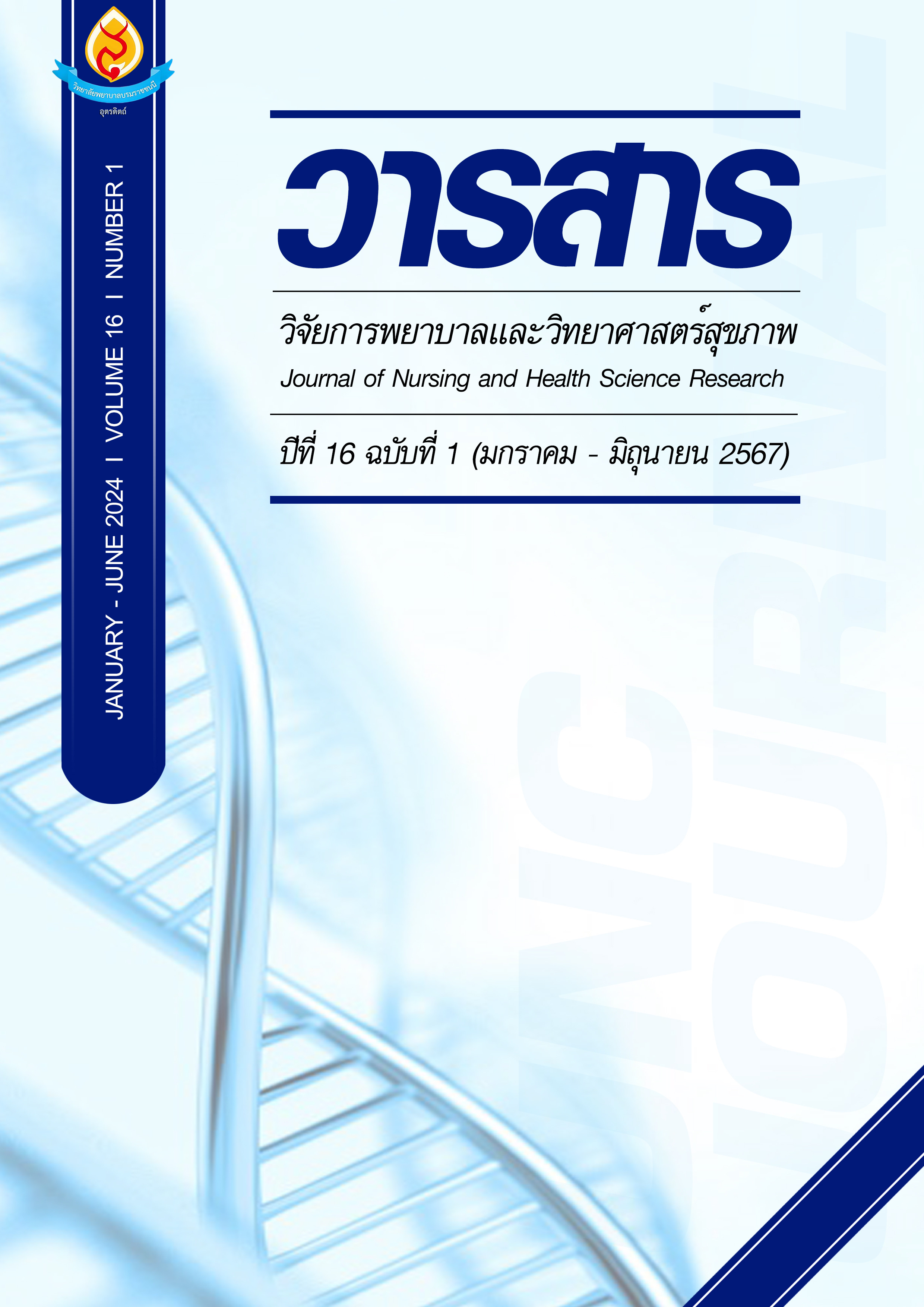ผลของโปรแกรมการส่งเสริมการรับรู้สมรรถนะแห่งตนต่อความเสี่ยงของการหกล้ม กำลังกล้ามเนื้อขา และความสามารถในการปฏิบัติกิจวัตรประจำวัน ในผู้ป่วยกระดูกสะโพกหัก โรงพยาบาลแพร่
Main Article Content
บทคัดย่อ
การวิจัยครั้งนี้เป็นการวิจัยกึ่งทดลอง แบบกลุ่มเดียววัดผลก่อนและหลังการทดลอง มีวัตถุประสงค์เพื่อศึกษาผลของโปรแกรมการส่งเสริมการรับรู้สมรรถนะแห่งตนต่อความเสี่ยงของการหกล้ม กำลังกล้ามเนื้อขา และความสามารถในการปฏิบัติกิจวัตรประจำวัน ในผู้ป่วยกระดูกสะโพกหัก โรงพยาบาลแพร่ กลุ่มตัวอย่าง คือ ผู้ป่วยที่ได้รับการวินิจฉัยจากแพทย์ว่ามีกระดูกสะโพกหักที่เข้ารับการรักษาโดยการผ่าตัดในโรงพยาบาลแพร่ จำนวน 30 คน เครื่องมือวิจัย ประกอบด้วย 1) โปรแกรมการส่งเสริมการรับรู้สมรรถนะแห่งตน 2) คู่มือการดูแลผู้ป่วยกระดูกสะโพกหัก 3) คลิปวิดีโอ เครื่องมือผ่านผู้ทรงคุณวุฒิ 5 ท่าน และค่าดัชนีความตรงตามเนื้อหาเท่ากับ 1 4) แบบประเมินความเสี่ยงของการหกล้ม 5) แบบประเมินกำลังกล้ามเนื้อขา และ 6) แบบประเมิน ความสามารถในการปฏิบัติกิจวัตรประจำวัน ความเชื่อมั่นของการประเมินระหว่างบุคคล (interrater reliability) และ คำนวณสัมประสิทธิ์ Cohen’s Kappa ได้เท่ากับ .81, .83 และ .86 วิเคราะห์ข้อมูลด้วยสถิติพรรณนา สถิติWilcoxson และPaired t- test
ผลการวิจัยพบว่าผู้ป่วยกระดูกสะโพกหักหลังได้รับโปรแกรมมีความเสี่ยงของการหกล้มลดลงกว่าก่อนได้รับโปรแกรม มีกำลังกล้ามเนื้อขาและมีความสามารถในการปฏิบัติกิจวัตรประจำวันสูงกว่าก่อนได้รับโปรแกรม อย่างมีนัยสำคัญทางสถิติที่ระดับ .001
ผลการศึกษานี้แสดงให้เห็นว่าโปรแกรมการส่งเสริมการรับรู้สมรรถนะแห่งตนสามารถส่งเสริมการรับรู้สมรรถนะแห่งตนของผู้ป่วยกระดูกสะโพกหักที่ได้รับการผ่าตัดหลังจำหน่ายในสัปดาห์ที่ 4 และบุคลากรทีมสุขภาพสามารถนำโปรแกรมการส่งเสริมการรับรู้สมรรถนะแห่งตนไปประยุกต์ใช้โดยเชื่อมโยงการดูแลต่อเนื่องสู่ชุมชนในระยะยาวเพื่อพัฒนาคุณภาพของการพยาบาลให้ดียิ่งขึ้น
Article Details

อนุญาตภายใต้เงื่อนไข Creative Commons Attribution-NonCommercial-NoDerivatives 4.0 International License.
บทความหรือข้อคิดเห็นใดใดที่ปรากฏในวารสารวิจัยการพยาบาลและวิทยาศาสตร์สุขภาพ เป็นวรรณกรรมของผู้เขียน ซึ่งบรรณาธิการหรือสมาคมศิษย์เก่า ไม่จำเป็นต้องเห็นด้วย และบทความที่ได้รับการตีพิมพ์เผยแพร่ถือเป็นลิขสิทธิ์ของวารสารวิจัยการพยาบาลและวิทยาศาสตร์สุขภาพ
เอกสารอ้างอิง
Bandura, A. (1997). Social foundations of thought and action (A social cognitive theory). New Jersey: Prentice-Hall.
Chueybuddha, C., Sripaoraya, S. & Yowsong, P. (2019). The effect of self- efficacy promotion program to re-fracture behavior in patients with femoral fractures receiving internalfixationin Krabi hospital. Krabi Medical Journal, 2(2), 9-16. (in Thai).
Cohen, J. (1992). Quantitative methods in psychology: a power primer. Psychol Bull, 112(1),155-169.
Committee to develop screening and health assessment tools for the elderly, Ministry of Public Health. (2021). Handbook for screening and assessing the health of the elderly 2021. Bangkok: Ministry of Public Health. (in Thai).
Department of Medical Services, Ministry of Public Health. (2022). Guideline for intermediate
care in hip fracture (fragility fracture) medical personnel medicine according to the health service system development plan (service plan). Bangkok: Sirindhorn National Medical Rehabilitation Institute, Department of Medical Services, Ministry of Public Health. (in Thai).
Jaipiti, H. & Sasat, S. (2018). The effect of self–efficacy promoting program on fear of fall in postoperative total hip replacement older persons. Journal of The Royal Thai Army Nurses, 19 (Supplement), 109-117. (in Thai).
Kendall, F. P. & McCreary, E. K. & Provance, P. G. (1993). Muscle-testing and function. (4 th edition), Baltimore: Williams & Wilkins.
National Statistical Office. (2021). Situation of the Thai elderly in spatial dimensions 2021. Bangkok: Forecasting Statistics Division National Statistical Office. (in Thai).
Orthopedic Surgery Department, Phrae Hospital. (2022). Statistics on hip fracture patients at orthopedic surgery department. Phrae hospital. (in Thai).
Pluemsong, K. (2022). The effect of home visit model in patients with post-operative hip fracture in contracting unit for primary care Maharaj Nakhon Si Thammarat hospital. Maharaj Nakhon Si Thammarat Medical Journal, 6(1), 18-30. (in Thai).
Polit, D. F. & Gillespie, B. (2009). The use of the intention to treat principle in nursing clinical trials. Nursing Research, 58(6), 391-399.
Sripiman, S., Thiangchanya, P. & Purinthrapibal, S. (2023). The effects of promoting self-care program to knowledge, self-efficacy, and self-care behaviors of patients with hip surgery at orthopedics ward, Songkhla hospital. Journal of Prachomklao College of Nursing, Phetchaburi Province, 3(2), 149-165. (in Thai).
Tajai, P., Hengnalen, B. & Sanguanpanich, Y. (2020). Hip fracture in older people: Roles of nurses in preventing complications before and after hip surgery. Christian University Journal, 26(4), 116-128. (in Thai).
The Thai Orthopedic Nurses Association. (2018). Nursing care of patients undergoing total knee replacement and clinical nursing practice guidelines for patients with hip fracture undergoing hip arthroplasty. Bangkok: N P place. (in Thai).
Thiamwong, L.,Thamarpirat, J., Maneesriwongul, W. & Jitapunkul, S. (2008). Thai falls risk assessment test (Thai-FRAT) developed for community-dwelling Thai elderly. Journal of the Medical Association of Thailand, 91(12), 1823-1832.
Trairatnopas, V. & Morsup, T. (2020). The roles of nurses on complication prevention in patients having traction for treatment of fracture. Christian University Journal, 26(3), 110-121. (in Thai).
Wongsanga, D. (2020). Exercise after hip surgery in hip fracture patients. Retrieved (2024, March 15). from http://pt.mhidol.ac.th/knowledge/?p=1941 (in Thai).


